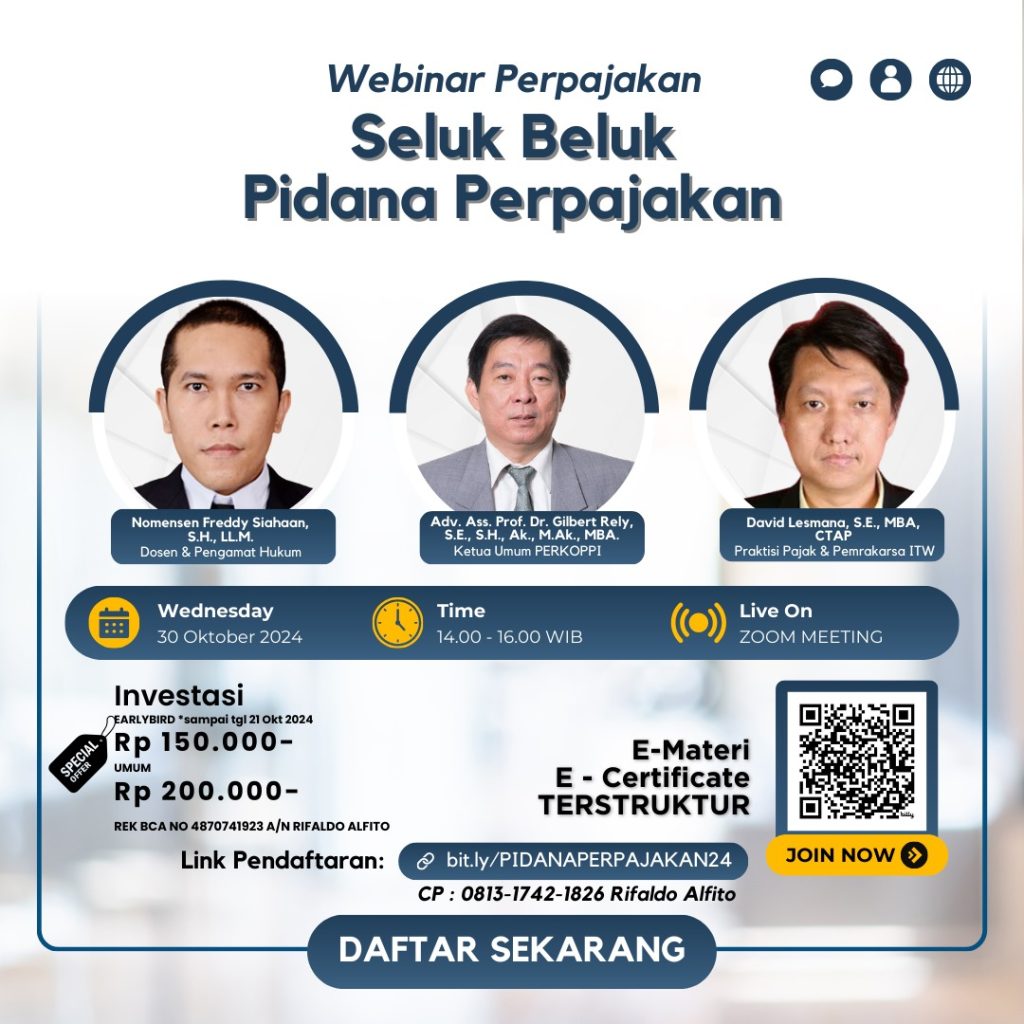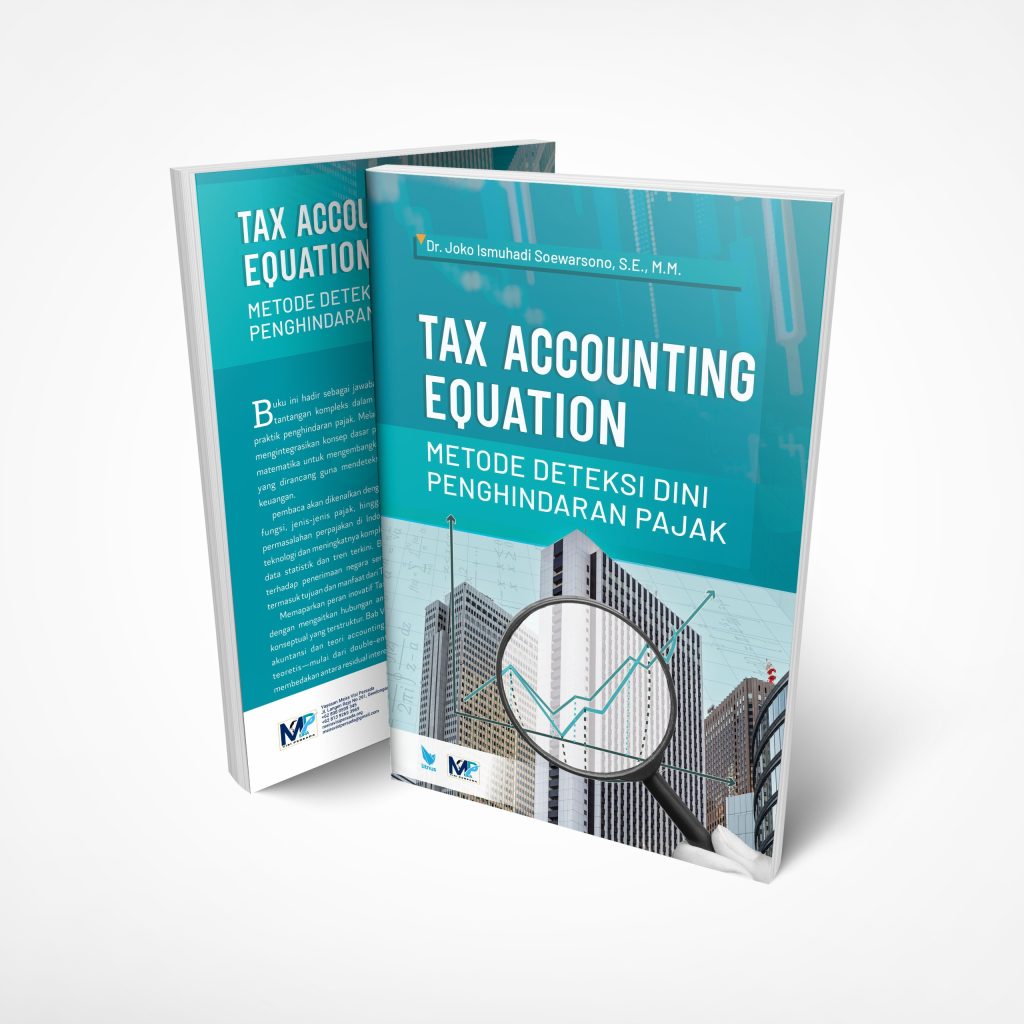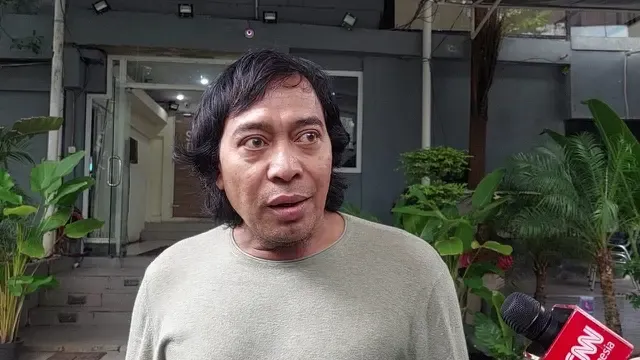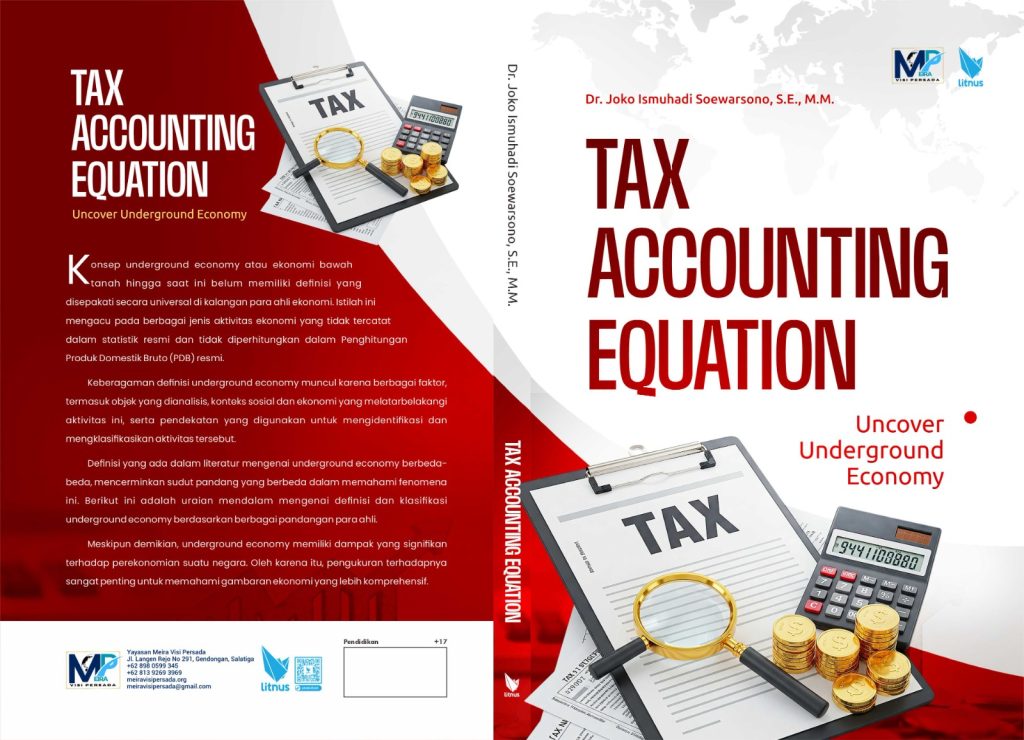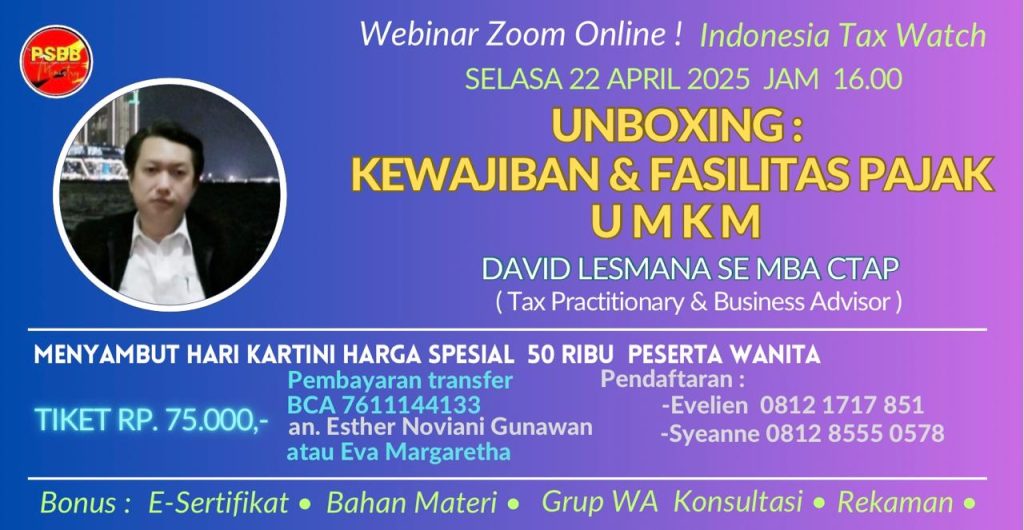
Dr. Joko Ismuhadi’s Tax Accounting Equation: A Forensic Approach to Detecting Financial Irregularities and Enhancing Tax Compliance in Indonesia
- Ekonomi
Wednesday, 18 June 2025 04:55 WIB
Jakarta, fiskusnews com:
Executive Summary
This report provides a comprehensive analysis of Dr. Joko Ismuhadi’s Tax Accounting Equation (TAE) and its complementary Mathematical Accounting Equation (MAE). These specialized analytical tools, derived from fundamental accounting principles, are designed with a specific focus on identifying potential tax irregularities and financial manipulation. The report details their theoretical basis, highlighting their strategic emphasis on revenue and profitability as key indicators for tax analysis. It explores their crucial applications in tax administration, particularly within Indonesia, where they serve as forensic accounting instruments for detecting tax avoidance, fraudulent activities, and hidden economic activity. A comparative analysis underscores TAE’s advantages over traditional audit methods and its synergy with emerging technologies like Artificial Intelligence and Machine Learning. While acknowledging the inherent limitations of accounting equations and the challenges of implementing advanced mathematical models in tax fraud detection, the report emphasizes TAE’s significant potential to enhance tax enforcement and contribute to state revenue mobilization in Indonesia. The analysis concludes with recommendations for further empirical validation, technological integration, and capacity building to maximize TAE’s impact on fiscal health.
Introduction: The Evolving Landscape of Tax Compliance and Financial Irregularities in Indonesia
Indonesia faces persistent and significant challenges in its tax revenue collection efforts, which directly impact its capacity to fund essential public services and infrastructure development. The nation’s tax-to-GDP ratio has consistently remained low, hovering around 10-12% in recent years, with figures of 10.39% in 2022 and 10.3% in 2023. This falls notably short of the 15% threshold generally recommended for developing countries and lags behind that of many peer nations. Such figures point to a substantial unrealized revenue potential and a significant tax gap, representing the difference between the tax that should be collected under full compliance and the amount actually received.
A primary impediment to optimizing tax revenue in Indonesia is the pervasive issue of tax evasion and the considerable scale of its underground economy. Research indicates that the informal sector constitutes a significant portion of the nation’s Gross Domestic Product, leading to substantial potential losses in tax revenue. Studies even suggest that approximately one-quarter of formal firms in Indonesia indirectly admit to evading taxes. This environment of widespread non-compliance presents a complex challenge for tax authorities.
The Indonesian tax system operates predominantly on a self-assessment basis, entrusting taxpayers with the responsibility to calculate, pay, and report their own taxes in accordance with prevailing laws and regulations. While this system is designed for efficiency, it inherently relies on the integrity of taxpayers. The prevalence of tax evasion and a large underground economy, however, directly contradicts this ideal. This creates a dynamic where the system’s efficiency is undermined by widespread non-compliance, necessitating robust internal monitoring mechanisms within organizations and sophisticated external enforcement tools to prevent errors and intentional misstatements. This situation highlights a fundamental dilemma: the efficiency gained from self-assessment is compromised by the reality of non-compliance, thereby underscoring the critical need for advanced, proactive detection tools that can bridge the gap between self-reported data and actual economic activity, moving beyond mere reliance on taxpayer honesty.
The Imperative for Advanced Analytical Tools in Tax Administration
To effectively address the deep-rooted challenges of tax evasion and the pervasive underground economy, Indonesia requires advanced tax analysis methodologies that can transcend the limitations of conventional auditing techniques. Traditional audit methods, while essential, can be time-consuming and often prove insufficient in uncovering increasingly sophisticated tax evasion schemes, which frequently involve intricate methods like the misclassification or concealment of economic activities. Such manipulations may not create a significant imbalance in the basic accounting equation, thereby limiting its effectiveness as a forensic tool in tax analysis.
Recognizing these limitations, the Directorate General of Taxation (DGT) in Indonesia has already begun leveraging advanced data analytics, including Artificial Neural Networks (ANN) and machine learning algorithms. This adoption signals a strategic shift towards data-driven, quantitative approaches in tax enforcement. These technologies are employed to detect suspicious patterns, predict taxpaying behavior, and enhance the overall efficiency and efficacy of tax administration by identifying potential non-compliance. Dr. Joko Ismuhadi’s Tax Accounting Equation (TAE), as a mathematically rigorous tool, fits seamlessly into this evolving landscape. It offers a specific, equation-based method that complements broader AI/ML efforts, suggesting a future where tax enforcement is less reliant on manual review and more on integrated, intelligent systems that can proactively identify anomalies. Such tools are becoming critical components of a modern tax administration strategy.
Dr. Joko Ismuhadi’s Tax Accounting Equation (TAE) and Mathematical Accounting Equation (MAE): Foundations and Formulas
Dr. Joko Ismuhadi’s Tax Accounting Equation (TAE) and Mathematical Accounting Equation (MAE) represent a significant evolution from traditional accounting principles, specifically tailored for the complexities of tax analysis and the detection of financial irregularities.
Derivation from the Fundamental and Expanded Accounting Equations
The fundamental accounting equation, Assets = Liabilities + Equity, serves as the bedrock of financial accounting. It establishes the equilibrium between a company’s resources (assets) and the sources from which those resources are financed, whether through borrowing (liabilities) or owner investments (equity). While foundational for understanding a company’s financial position at a specific point in time, this basic equation’s general nature is often insufficient to uncover sophisticated tax evasion. Such evasion frequently involves concealed or misclassified economic activities that may not create a significant imbalance in the basic equation, thereby limiting its effectiveness as a forensic tool in tax analysis.
The expanded accounting equation (Assets = Liabilities + Owner’s Capital + Retained Earnings) builds upon this foundation by further detailing equity. It incorporates elements such as revenues, expenses, and withdrawals or dividends, offering a more dynamic perspective on how operational activities and shareholder decisions directly influence a company’s financial health.
Dr. Ismuhadi’s TAE and MAE are strategic rearrangements and adaptations of these fundamental principles, specifically tailored for tax analysis. The brilliance of these equations lies in their ability to bridge the gap between financial reporting and tax reality. The basic accounting equation provides a static snapshot of financial position, whereas tax evasion often involves manipulating income statement elements (revenue, expenses) or balance sheet classifications (e.g., misclassifying income as debt). The TAE and MAE explicitly link income statement components (Revenue, Expenses) with balance sheet components (Assets, Liabilities). This direct linkage is crucial because it compels a reconciliation between reported profitability and changes in net worth, making it significantly harder to hide manipulation that might otherwise balance the basic accounting equation. Consequently, TAE and MAE are designed to expose the dynamic flow of economic activity and its impact on the balance sheet, rather than merely the static financial position, which is a more effective approach for detecting sophisticated tax fraud.
Detailed Formulations of TAE and MAE
Dr. Ismuhadi has formulated the Tax Accounting Equation (TAE) in two interrelated forms:
- Revenue – Expenses = Assets – Liabilities
- Revenue = Expenses + Assets – Liabilities
These formulations are essentially algebraic rearrangements of the same underlying relationship. They strategically emphasize profitability (Revenue – Expenses) from the income statement and net worth (Assets – Liabilities) from the balance sheet.
Furthermore, for specific scenarios where taxable income might be intentionally reported as zero or negative to minimize tax liabilities, Dr. Ismuhadi has also formulated the Mathematical Accounting Equation (MAE) as:
- Assets + Dividend + Expenses = Liabilities + Equity + Revenue. The inclusion of “Beban” (Expenses), “Kewajiban” (Liabilities), “Ekuitas” (Equity), and “Pendapatan” (Revenue) as Indonesian terms within the MAE highlights its localized context and specific design for the Indonesian financial landscape. This equation further refines the analytical approach to address situations where income statement manipulation might not be the primary method of tax avoidance.
Strategic Emphasis on Revenue and Profitability for Tax Analysis
The TAE formulations deliberately emphasize revenue as a critical indicator of a company’s economic activity and its consequent tax obligations. This focus is particularly significant because underreporting income is a common and pervasive tactic in tax evasion. By mathematically linking revenue, expenses, assets, and liabilities, TAE provides a robust framework for tax authorities and organizations to quantitatively assess financial statements.
This approach facilitates the proactive detection of income manipulation. Traditional accounting equations primarily focus on maintaining balance; however, TAE shifts the emphasis to revenue and profitability, which are often primary targets for tax evasion. By establishing an “expected equilibrium” between these elements, TAE allows for the identification of discrepancies that directly point to potential income manipulation, rather than just overall financial imbalance. This targeted approach makes TAE a more efficient mechanism for tax authorities to identify potential issues, allowing them to prioritize investigations where income underreporting is suspected.
Table 1: Comparison of Basic, Expanded, and Tax Accounting Equations
| Equation Type | Formula | Primary Focus | Key Components Emphasized | Purpose in Tax Context |
|---|---|---|---|---|
| Basic Accounting Equation | Assets = Liabilities + Equity | Financial Position | Assets, Liabilities, Equity | General understanding (limited for tax evasion) |
| Expanded Accounting Equation | Assets = Liabilities + Owner’s Capital + (Revenues – Expenses – Withdrawals) | Detailed Equity Changes/Operational Impact | Assets, Liabilities, Owner’s Capital, Revenues, Expenses, Withdrawals | Deeper financial performance (limited for tax evasion) |
| Tax Accounting Equation (TAE) | Revenue – Expenses = Assets – Liabilities <br> Revenue = Expenses + Assets – Liabilities | Profitability vs. Net Worth for Tax Analysis | Revenue, Expenses, Assets, Liabilities | Early detection of tax irregularities, underreporting, misclassification |
| Mathematical Accounting Equation (MAE) | Assets + Dividend + Expenses = Liabilities + Equity + Revenue | Addressing Zero/Negative Taxable Income Scenarios | Assets, Dividend, Expenses, Liabilities, Equity, Revenue | Addressing specific income statement manipulation for tax minimization |
Application and Operationalization of TAE and MAE
The utility of Dr. Ismuhadi’s Tax Accounting Equation (TAE) and Mathematical Accounting Equation (MAE) extends across various facets of tax administration and corporate compliance, particularly in the Indonesian context.
Role in Tax Audits and Investigations by Tax Authorities
TAE is primarily applied in tax administration and enforcement, especially in countries like Indonesia where tax evasion and financial irregularities are significant concerns. It is specifically designed for tax authorities to proactively detect financial irregularities, potential tax avoidance, and fraudulent activities. By analyzing financial statements through the lens of TAE, tax officials can identify inconsistencies that might suggest intentional misreporting of revenue or expenses.
The deviations identified by TAE serve as strong indicators of potential tax evasion or fraudulent activities, effectively directing audit efforts towards high-risk entities. This capability significantly enhances audit efficiency and targeting. Traditional audits can be time-consuming and may often miss sophisticated schemes. However, TAE’s ability to flag specific discrepancies means that auditors can focus their limited resources on cases with a higher likelihood of non-compliance. This shifts the audit paradigm from broad, potentially inefficient examinations to targeted, data-driven investigations. Ultimately, TAE acts as a filter, optimizing the allocation of audit resources and increasing the probability of detecting significant tax evasion, thereby improving overall tax enforcement effectiveness.
Integration within Self-Assessment Monitoring Systems (SAMS) for Internal Control
Companies and organizations can leverage TAE as a forensic accounting tool within Self-Assessment Monitoring Systems (SAMS) to enhance internal controls and ensure tax compliance. Integrating TAE into a SAMS establishes a data-driven internal mechanism for identifying potential tax risks and ensuring the accuracy of financial data. This proactive monitoring framework is particularly valuable in the Indonesian context, helping organizations manage their tax obligations and mitigate associated risks.
The consistent use of TAE for self-assessment allows companies to build a stronger audit trail and demonstrate their commitment to tax compliance. The documented application of TAE, along with any identified discrepancies and corresponding corrective actions, can provide external auditors with greater confidence in the organization’s internal controls and the reliability of its financial reporting, potentially streamlining external audits. This internal application of TAE transforms tax compliance from a reactive, year-end reporting exercise into a continuous, proactive risk management process. This fosters a stronger culture of compliance within organizations, reduces the likelihood of penalties, and prepares them for external scrutiny by identifying and rectifying issues before they escalate into major problems.
Forensic Accounting Capabilities: Identifying Specific Financial Manipulations
TAE’s strength lies in its ability to highlight inconsistencies that might not be immediately apparent through traditional accounting analysis, making it an invaluable tool in the fight against tax evasion and financial irregularities [User Query]. It helps identify various deceptive practices, including:
- Underreporting Income: The equation can flag situations where a company reports significantly low revenues while simultaneously showing an unexplained increase in assets.
- Inflated Expenses: Discrepancies may arise if expenses are unusually high without corresponding revenue or asset growth.
- Misclassifying Income as Debt: An unusually high level of liabilities relative to reported revenue growth could suggest an intentional misclassification of income as debt to reduce the tax burden. This tactic might involve the use of related party transactions to obscure the true nature of financial flows.
- Inconsistencies between Profitability and Net Worth: Discrepancies between a company’s reported profitability (from the income statement) and its net worth (from the balance sheet) can signal potential manipulation of financial statements to evade taxes.
- Use of Clearing Accounts: TAE is designed to detect deceptive practices such as the temporary misrecording of revenues as liabilities or expenses as assets through the use of clearing accounts.
Furthermore, TAE provides valuable insights into the scale and nature of the underground economy. By flagging situations where a company’s reported revenue is insufficient to support its reported expenses and asset growth, it can indicate the presence of unreported income from hidden economic activities. The underground economy is a significant challenge because it operates largely outside the formal tax system. TAE’s ability to detect inconsistencies that hint at undeclared income or activity offers a mechanism to indirectly “formalize” these informal activities by bringing them into the tax net. This positions TAE as a tool for expanding the tax base and fostering greater economic transparency, contributing to a fairer and more robust tax system.
The Process of Application: Data Collection, Equation Calculation, Deviation Analysis, Anomaly Investigation, and Risk Assessment
The application of TAE involves a structured investigative framework:
- Data Collection: This initial step requires gathering comprehensive financial data from a company’s income statement and balance sheet, including revenues, expenses, assets, and liabilities [User Query].
- Equation Calculation: The collected financial data is then inputted into the TAE (or MAE) formulas [User Query].
- Deviation Analysis: The results of the equation are compared with expected or benchmark relationships. Significant deviations from anticipated mathematical relationships between these financial components serve as indicators of potential tax avoidance or fraudulent activities.
- Anomaly Investigation: When deviations are identified, further in-depth investigation and forensic accounting techniques are employed to understand the root cause of the imbalance. This might involve scrutinizing specific transactions, looking for hidden accounts, or analyzing complex financial structures [User Query].
- Risk Assessment: The findings from the investigation help tax authorities or internal auditors assess the level of tax risk and determine appropriate actions, such as further audits, penalties, or legal proceedings [User Query].
This systematic approach ensures that mathematical flags are followed by targeted, in-depth scrutiny. It provides a clear, actionable roadmap for tax authorities and internal auditors, transforming raw financial data into actionable intelligence for compliance and enforcement.
Table 2: Key Applications and Target Irregularities of TAE/MAE
| Application Area | Targeted Irregularity/Manipulation | Mechanism of Detection (TAE/MAE Indicator) | Context/Benefit |
|---|---|---|---|
| Tax Audits & Investigations | Underreported Revenue, Inflated Expenses | Deviations from expected equilibrium (e.g., low revenue/high assets, high expenses/low revenue) | Proactive detection, enhanced audit efficiency |
| Internal Control (SAMS) | Misclassification of Income as Debt, Inconsistencies between Profitability and Net Worth | High liabilities/low revenue growth, low profitability/high net worth | Data-driven internal monitoring, risk mitigation |
| Forensic Accounting | Use of Clearing Accounts, Hidden Economic Activity/Underground Economy | Unusual inverse relationships (e.g., revenues as liabilities, expenses as assets), reported revenue insufficient for expenses/asset growth | Uncovering sophisticated evasion, insights into shadow economy |
Theoretical Underpinnings and Comparative Analysis
The efficacy of Dr. Ismuhadi’s Tax Accounting Equation (TAE) stems from its distinct theoretical underpinnings and its complementary relationship with both traditional and emerging tax audit methodologies.
Mathematical Principles for Establishing Financial Equilibrium and Detecting Deviations
The underlying mathematical principle of TAE is to establish an expected equilibrium between key financial reporting components—namely, revenue, expenses, assets, and liabilities—and a company’s tax obligations. Significant deviations from these anticipated relationships serve as critical indicators of potential tax avoidance or fraudulent activities. TAE provides a quantitative framework to assess financial statements, enabling a shift from traditional qualitative assessments towards a more rigorous, data-driven methodology. The core idea is that a company’s reported financial performance (profitability) should logically align with its reported financial position (net worth).
While the basic accounting equation ensures that debits equal credits, it does not necessarily guarantee economic logic or consistency between different financial statements when manipulation occurs. TAE’s strength lies in applying a “logical consistency” principle: profitability from the income statement must align with changes in net worth from the balance sheet for tax purposes. Deviations from this alignment signal a break in this logical consistency, indicative of underlying manipulation. This principle allows TAE to act as a powerful diagnostic tool, not just for numerical errors, but for uncovering deceptive financial narratives.
Comparison with Traditional Tax Audit Methods in Indonesia (Direct and Indirect)
Traditional tax audit techniques employed by the Directorate General of Taxes (DGT) in Indonesia typically include:
- Direct Methods: These involve the detailed examination of books, records, and documents related to specific income or expense items.
- Indirect Methods: These approaches, such as the cash transaction and bank deposit method, are used to assess the reasonableness of reported income by inferring economic activity from external indicators.
While these traditional methods are essential components of tax enforcement, they can be time-consuming and may not always be sufficient to uncover sophisticated tax evasion schemes. They may also struggle to fully account for the prevalence of the underground economy in Indonesia.
In contrast, TAE offers a unique, mathematically derived, equation-based approach that provides a targeted lens for identifying potential irregularities. It complements traditional methods by highlighting inconsistencies that might be missed by broader data analysis or manual reviews. Traditional audit methods are primarily verificative, checking reported records. Sophisticated evasion, however, often involves concealment or misrepresentation that can pass basic checks. TAE, by identifying deviations from an expected equilibrium, moves towards predictive anomaly detection. It does not merely verify what is reported; it flags what should be reported based on other financial indicators. This makes TAE a proactive “early warning system” that can significantly enhance the efficiency and effectiveness of audits by directing resources to higher-risk areas, rather than relying solely on post-facto verification.
Synergy with Emerging Technologies: Advanced Data Analytics and Machine Learning in Tax Fraud Detection
The DGT is already actively leveraging advanced data analytics, including Artificial Neural Networks (ANN) and machine learning (ML) algorithms, to predict taxpaying behavior and detect suspicious patterns. These technologies offer powerful capabilities for analyzing vast amounts of data and identifying complex fraud patterns that might be difficult for human auditors to discern.
TAE provides a specific, mathematically derived equation-based approach that can complement these broader data analytics methods. It can be integrated into automated analytical tools to apply the equation to vast amounts of financial data efficiently. Modern tax fraud detection is increasingly moving towards AI/ML. While powerful, these models can sometimes function as “black boxes,” posing challenges for interpretability. TAE, as a transparent, equation-based model, can provide interpretable insights into why a discrepancy exists (e.g., misclassification of income as debt). This creates a “hybrid intelligence” approach where AI/ML identifies broad patterns, and TAE provides specific, explainable flags for forensic investigation. This synergy allows for both broad-scale detection and precise, explainable anomaly identification, enhancing the overall robustness and trustworthiness of tax fraud detection systems.
Table 3: Comparison of TAE with Traditional Indonesian Tax Audit Methods
| Method | Primary Focus | Strengths | Limitations | Role in Fraud Detection | Complementary Nature |
|---|---|---|---|---|---|
| Traditional Direct Audit | Verification of specific transactions/records | Detailed transaction-level verification | Time-consuming, may miss sophisticated schemes, relies on available records | Reactive verification | Forms the basis for detailed follow-up investigations |
| Traditional Indirect Audit | Reasonableness of reported income (based on external indicators) | Useful for assessing undeclared income (e.g., cash flow analysis) | Can be inferential, may not pinpoint specific manipulation types | Inferred detection | Provides external context |
| Tax Accounting Equation (TAE) | Logical consistency between financial statements for tax purposes | Quantitative, targeted, early detection of specific manipulations | Requires accurate financial data, currently lacks extensive public empirical case studies | Proactive anomaly detection and forensic flagging | Identifies internal inconsistencies for deeper scrutiny |
Limitations and Challenges
While Dr. Joko Ismuhadi’s Tax Accounting Equation (TAE) offers significant advancements in tax fraud detection, its implementation and effectiveness are subject to certain limitations and challenges inherent in both accounting methodologies and the broader landscape of financial forensics.
Inherent Limitations of Accounting Equations in Comprehensive Financial Analysis
The basic accounting equation, while fundamental, represents an over-simplification of complex company finances. It provides a static snapshot of a company’s financial position at a specific point in time and does not inherently reflect current market value. Furthermore, it lacks operational insights and does not comprehensively capture the nuances of revenue and expense details. The equation also does not indicate the risks associated with assets or liabilities, such as the risk of bad debts or asset obsolescence. Importantly, the values within any accounting equation can be significantly influenced by a company’s chosen accounting methods and policies, which may not always provide the most transparent picture of financial health.
TAE, while an advancement designed to detect manipulation, still operates on reported financial data [User Query]. This brings to the forefront the principle of “garbage in, garbage out.” If the underlying data itself is fundamentally fabricated or systematically distorted (e.g., through fake invoices, phantom assets, or complex shell company structures), even a sophisticated equation like TAE might struggle to identify the true underlying reality without external corroboration. This underscores that TAE is a powerful indicator of potential issues, but it is not a standalone solution. Its findings necessitate robust data collection, validation, and subsequent in-depth forensic investigation to confirm and quantify irregularities.
Challenges in Implementing Advanced Mathematical Models for Tax Fraud Detection
Implementing advanced mathematical models for tax fraud detection, including TAE, faces several significant challenges:
- Data Quality and Availability: Tax return data are highly sensitive and legally protected, which severely limits the availability of publicly accessible datasets for research and model development. Moreover, a lack of proper bookkeeping and insufficient transaction documentation within companies can hinder accurate regulatory reporting and lead to intense scrutiny during audits.
- Class Imbalance Problem: Fraudulent transactions typically constitute a very small fraction of total tax records. This severe class imbalance makes it difficult for machine learning models, and by extension, equation-based anomaly detection systems, to learn meaningful fraud patterns. Models may exhibit a bias towards classifying transactions as legal, potentially leading to poor detection performance for actual fraud.
- Model Interpretability: While TAE is arguably more interpretable than “black box” Artificial Intelligence or Machine Learning models, some advanced mathematical models can still be complex. This complexity can make it challenging to fully understand why a specific flag was raised, which is crucial for legal proceedings, evidence presentation, and effective policy adjustments.
- Evolving Evasion Tactics: Tax evaders continuously develop more sophisticated strategies to minimize their tax liabilities. This dynamic nature means that any fixed mathematical model or algorithm risks becoming obsolete over time. Models need to adapt continuously to these evolving threats.
- Jurisdictional Complexity: Accounting for income taxes can be highly complex, particularly for companies operating in multiple jurisdictions. Issues such as jurisdictional netting of deferred tax assets/liabilities or differing carryforward periods can lead to missed items or improper disclosures, complicating the application of a universal equation.
- Ethical Considerations and Privacy: The use of advanced analytics on sensitive taxpayer data raises significant privacy and ethical concerns. Balancing the need for effective fraud detection with the protection of individual and corporate privacy is a critical consideration.
The dynamic nature of tax evasion means that any fixed mathematical model or algorithm risks becoming obsolete. The challenges of data imbalance and privacy further complicate model training and validation. Therefore, continuous research, model refinement, and secure data sharing mechanisms are essential for TAE and similar tools to remain effective against evolving fraud techniques. This necessitates a proactive, iterative development approach.
Absence of Publicly Documented Empirical Case Studies for TAE’s Real-World Application
A notable challenge for the broader acceptance and validation of TAE is the current absence of specific, publicly documented empirical case studies detailing its real-world application and the irregularities actually detected using Dr. Joko Ismuhadi’s Tax Accounting Equation in real-world investigations. The provided research material consistently highlights the potential and design of TAE for detecting financial irregularities, offering hypothetical examples of how it could be used. However, these discussions often conclude with recommendations for rigorous empirical studies to evaluate its effectiveness in real-world scenarios within Indonesia.
While Dr. Ismuhadi has published scholarly work on tax manipulation and money laundering , and his contributions are discussed on various platforms , concrete, publicly available empirical evidence demonstrating TAE’s direct application results in specific tax audit outcomes is not detailed in the provided information. This indicates a crucial gap between the theoretical promise and widespread, verifiable practical validation in the public domain. The theoretical promise of TAE is strong as a “pioneering tool” with “significant potential”. However, the repeated mention of potential and recommendations for empirical studies, coupled with the absence of specific, documented successful detections, indicates a critical need for further validation. For TAE to gain broader acceptance and become a standard tool in tax administration, rigorous empirical studies and documented case successes are paramount to demonstrate its tangible impact on tax revenue collection and fraud deterrence. This represents a key area for future research and public reporting.
Table 4: General Challenges in Applying Quantitative Models for Tax Fraud Detection
| Challenge Category | Specific Challenge | Impact |
|---|---|---|
| Data Issues | Data Sensitivity/Privacy | Limits research/development, raises public/legal concerns |
| Data Issues | Class Imbalance | Biases model performance, leads to poor fraud detection |
| Data Issues | Data Quality/Documentation | Hinders accurate reporting/audits, reduces reliability of model inputs |
| Model Limitations | Model Interpretability | Reduces trust/adoption, complicates legal proceedings and policy adjustments |
| Operational/Contextual Challenges | Evolving Evasion Tactics | Requires continuous updates and refinement of models |
| Operational/Contextual Challenges | Jurisdictional Complexity | Complicates cross-border analysis, leads to missed items in multi-jurisdictional entities |
| Operational/Contextual Challenges | Resource Allocation | Increases operational costs for data collection, processing, and expert analysis |
| Operational/Contextual Challenges | Ethical Considerations | Requires careful balancing of detection needs with privacy rights |
Impact and Future Potential for Indonesian Tax Compliance
Dr. Joko Ismuhadi’s Tax Accounting Equation (TAE) and Mathematical Accounting Equation (MAE) hold substantial promise for significantly enhancing tax compliance and combating financial irregularities in Indonesia. Their unique design and targeted application align directly with the nation’s pressing fiscal challenges.
Contribution to Enhanced Tax Enforcement and State Revenue Mobilization
TAE holds significant potential for transforming tax administration and enforcement in Indonesia. By providing a mathematically rigorous framework for analyzing financial data, TAE can contribute to a more sophisticated, forensic, and data-driven approach to combating tax evasion. This enables tax authorities to move beyond traditional qualitative assessments of financial statements towards a quantitative methodology for identifying potential irregularities. Such a shift can lead to enhanced identification of potential non-compliance through improved risk assessment modeling.
Indonesia’s consistently low tax ratio and substantial tax gap directly impact its ability to fund economic growth and provide essential public services. The ability of TAE to enhance detection and enforcement directly translates into increased state revenue mobilization. This is not merely about identifying and penalizing fraudsters; it is fundamentally about building fiscal resilience for national development. If effectively implemented and validated, TAE can serve as a cornerstone in Indonesia’s broader economic strategy to achieve higher revenue-to-GDP ratios and fund ambitious development plans.
Addressing the Challenges Posed by the Underground Economy
TAE is particularly relevant and specifically designed for the Indonesian financial and regulatory landscape, taking into account unique challenges such as the prevalence of the underground economy and various tax evasion tactics. It can provide valuable insights into the scale and nature of the underground economy by identifying discrepancies between reported financial data and expected tax obligations.
The emphasis on early detection of Underground Economic Activity (UEA) underscores TAE’s potential to address a significant challenge in Indonesia, where the informal sector is a major source of tax evasion. The underground economy presents a significant challenge because it operates largely outside the formal tax system. TAE’s ability to detect inconsistencies that hint at undeclared income or activity offers a mechanism to indirectly “formalize” these informal activities by bringing them into the tax net. This positions TAE as a tool for expanding the tax base and fostering greater economic transparency, contributing to a fairer and more robust tax system.
Recommendations for Further Research, Development, and Broader Implementation
To maximize the impact of Dr. Ismuhadi’s Tax Accounting Equation and facilitate its broader adoption, several key recommendations are proposed:
- Empirical Validation: Rigorous empirical studies are crucial to evaluate TAE’s effectiveness in real-world scenarios within Indonesia. These studies should provide concrete case studies and quantifiable results of its application in detecting actual financial irregularities and tax evasion. This will bridge the gap between theoretical promise and proven practical impact.
- Integration with AI/ML Platforms: Further exploration and development of automated analytical tools that seamlessly integrate TAE with advanced data analytics, Artificial Intelligence, and Machine Learning platforms are recommended for large-scale, efficient application. This hybrid approach will leverage the strengths of both methodologies.
- Data Infrastructure Enhancement: Investment in enhancing data infrastructure is essential to enable the efficient implementation of TAE on vast amounts of financial data. This includes improving data collection, storage, and accessibility to support advanced analytical tools.
- Capacity Building: Comprehensive and specialized training programs for tax auditors, forensic accountants, and internal audit teams are necessary to ensure proficient application and accurate interpretation of TAE and MAE results [User Query]. This will build the human capital required for effective utilization.
- Policy and Regulatory Alignment: Continuous review and adaptation of tax laws and regulations are recommended to support the effective application of advanced analytical tools like TAE. This may involve clarifying the treatment of complex financial transactions for tax purposes to reduce ambiguity and potential disputes.
- International Collaboration: Given the foundational principles of TAE, exploring its potential for application beyond Indonesia and fostering collaboration with international tax authorities on best practices for using such analytical tools could yield valuable insights and mutual benefits.
The effectiveness of TAE is not solely dependent on the equation itself, but on its integration into a larger “ecosystem of compliance.” This encompasses robust data infrastructure, highly skilled human expertise, supportive legal frameworks, and complementary technologies. Therefore, successful long-term implementation requires a multi-faceted strategy that combines technological advancement with human capital development and a continuously supportive regulatory environment.
Conclusion
Dr. Joko Ismuhadi’s Tax Accounting Equation (TAE) and Mathematical Accounting Equation (MAE) represent innovative and highly tailored forensic accounting tools with significant potential for enhancing tax compliance and combating financial irregularities, particularly within Indonesia. These equations offer a unique contribution by providing a quantitative, targeted lens for identifying discrepancies that traditional methods might overlook. Their strategic emphasis on the logical consistency between a company’s profitability and its net worth allows for the proactive detection of income manipulation and the inference of hidden economic activity, thereby addressing critical challenges posed by tax evasion and the underground economy.
While the theoretical promise of TAE is substantial, its full impact hinges on continued empirical validation through rigorous studies. Furthermore, its optimal effectiveness will be realized through seamless integration with advanced data analytics and machine learning platforms, fostering a “hybrid intelligence” approach to tax fraud detection. The successful long-term implementation of TAE requires a holistic “ecosystem of compliance” that combines technological advancement with robust data infrastructure, continuous capacity building for tax professionals, and a supportive, adaptive regulatory environment. By pursuing these avenues, TAE can become an indispensable tool in strengthening Indonesia’s tax administration, contributing significantly to state revenue mobilization, and fostering greater fiscal health and transparency.
Reporter: Marshanda Gita – Pertapsi Muda
Share
Berita Lainnya
Menggali Rahasia Tax Ratio: Wawasan Mendalam dari Balast POD Dengan Narasumber Dr. Imam Nashirudin, Kepala KPP Pratama Bandar Lampung Satu
SIKAP KPP PMA TIGA ATAS TRANSAKSI YANG MENCURIGAKAN
Berguru Kepada TENZING NORGAY
PERTAPSI bersama DJP menghadirkan Sosialisasi SPT Masa Januari 2025 melalui Aplikasi CORE TAX
Short Course Perpajakan yang diselenggarakan oleh Yayasan Meira Visi Persada
Rekomendasi untuk Anda

Berita Terbaru
Eksplor lebih dalam berita dan program khas fiskusnews.com
Tag Terpopuler
# #TAE
# #TAX ACCOUNTING EQUATION
# #TAX FRAUD
# #TAX EVASION

